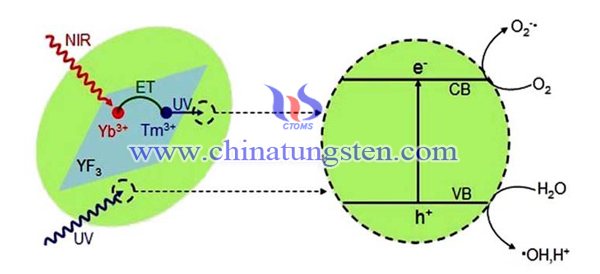Energy Storage Type Tungsten Trioxide Photocatalyst
- Details
- Category: Tungsten Information
- Published on Friday, 27 May 2016 17:33
The two conditions of generating photocatalysis: light and photocatalyst exist, both of them indispensable. In general, titanium dioxide photocatalyst at a specific wavelength (388nm) light irradiation, will produce a series of energy conversion process which similar to plant photosynthesis chlorophyll, translate the light energy into chemical energy to endow the photocatalyst surface with a strong oxidation, thus to oxidize and decompose various organic and mineralized inorganic substances, furthermore to have antibacterial effects. However, titanium dioxide can only exhibit the high photocatalytic activity when irradiated with UV light of sufficient intensity, and almost have no activity under the visible light. There is almost no ultraviolet light in indoor environment; therefore, titanium dioxide indoors can hardly complete photocatalytic reaction by itself in indoor low light or no light environments.

Studies have indicated that by the incorporation of energy storage type of materials, this problem can be well solved. Tungsten trioxide and molybdenum trioxide are capable of reducing energy and energy storage type of materials, titanium dioxide generates electrons and holes in the excitation of light, and passes to the energy storage types of materials; while the energy storage types of materials obtain the electronic, to maintain a certain internal to attract cationic charge, they will release energy while reducing oxygen to form a peroxy acid antibacterial effect in the dark to reach. Storage types of photocatalyst here is which still able to continue to play a role in the efficient photocatalytic activity under weak light or no light conditions.
In addition, the kind of energy storage type of materials are also adding rare earth elements as activator, so that the storage photocatalytic composite material capable of photocatalysis in low light and no light condition. The essence of rare earth elements storing energy is generated by the essence of unfilled 4f electron transition layer, since the 4f shell electrons are shielded by 5s and 5p shells of electrons, on the crystal field line position of little influence, so the crystal field of energy level similar to free electron energy levels, the performance of the discrete level. The essence of the object emitting is the energy conversion, so, the rare earth element has optical properties which can not be compared. In addition, the special electronic structure of rare earth elements makes them having very strong spectroscopic properties, with the luminous range covers almost the entire category of solid light, and the energy which it absorbs will be given off in the form of light; at the same time, the wealth of electronic energy levels create the conditions for different energy level transitions, thus the rare earth elements will have the access to having variety of luminescent properties.
The combined applications of titanium dioxide with tungsten trioxide, molybdenum trioxide and rare earth elements which can use the light source to photosensitive storage, thus to form the composite material of energy storage type tungsten trioxide photocatalyst, playing their own respective advantages, and broaden the application field of photocatalyst.
| Tungsten Oxide Supplier: Chinatungsten Online www.tungsten-oxide.com | Tel.: 86 592 5129696; Fax: 86 592 5129797;Email:sales@chinatungsten.com |
| Tungsten News & Prices, 3G Version: http://3g.chinatungsten.com | Molybdenum News & Molybdenum Price: http://news.molybdenum.com.cn |



 sales@chinatungsten.com
sales@chinatungsten.com